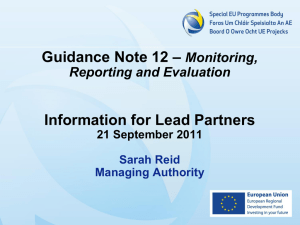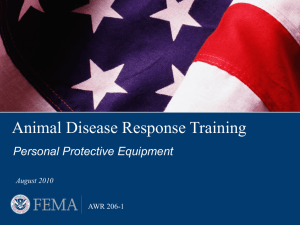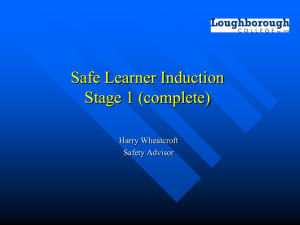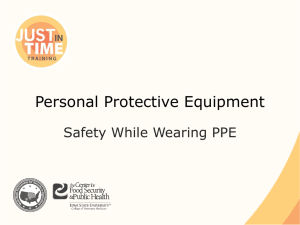Chapter 6
advertisement
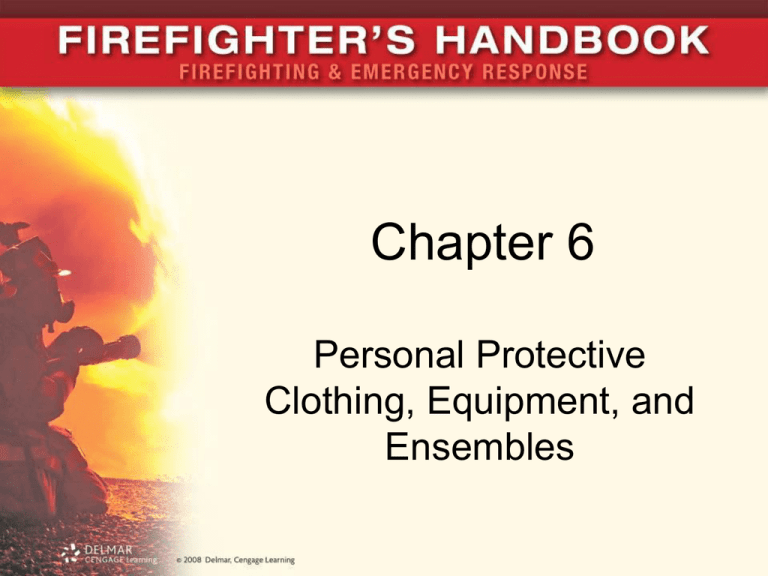
Chapter 6 Personal Protective Clothing, Equipment, and Ensembles Introduction • Difference between injury and safety determined by personal protective equipment (PPE) • PPE provides a minimum level of protection • PPE is the primary layer of protection • PPE includes full protective clothing plus a self-contained breathing apparatus (SCBA) – Personal Alert Safety System (PASS) device 6.2 Introduction (cont'd.) • Defined collections of personal protective clothing designed for different firefighter hazards • Exceeding limitations of ensemble's components can cause injury • Firefighters must don the equipment properly • Many factors influence PPE design and use 6.3 Figure 6-1 A hostile fire within a structure creates an IDLH environment. Personal protective equipment can help the firefighter work in an IDLH environment. 6.4 Personal Protective Equipment Factors • Firefighter PPE has evolved over two decades • Result of labor groups such as International Association of Firefighters • National Fire Protection Association provides forum for consensus building • Federal government involved in PPE equation – Development of regulations and guidelines 6.5 Standards and Regulations • NFPA developed standards for: – Firefighter protective clothing – Equipment – Ensembles • NFPA developed “use” standard • All protective clothing worn must meet current applicable standards • OSHA responsible for development and enforcement of regulations 6.6 Figure 6-3 NFPA-compliant PPE components should have a permanently affixed label. 6.7 Types of Personal Protective Ensembles • Ensemble: – Multiple elements of protective clothing and equipment worn together – Provide protection from some risks • All components must be utilized as recommended 6.8 Structural Firefighting Protective Ensemble • Protective ensemble for structural firefighting: – – – – – – – – Coats and trousers Helmets Eye protection Gloves Footwear Protective hoods Hearing protection Station/ work uniform 6.9 Figure 6-4 A full structural firefighting ensemble includes more than the NFPA minimum required components. 6.10 Proximity Firefighting Protective Ensemble • Most often associated with aircraft rescue and firefighting (ARFF) • Aluminized coating reflects radiant heat • Not designed for fire entry • Hood features a full face shield coated with anodized gold material 6.11 (A) (B) Figure 6-14 Proximity firefighting ensembles can utilize (A) a special helmet or (B) a full hood. Either can interface with an SCBA. Note the gold-anodized visors. 6.12 Wildland Firefighting Protective Ensemble • Called brush gear • Addresses specific needs of wildland firefighters: – Lightweight and breathable – Firm ankle support – Hot ember protection • Synthetic material should never be worn under wildland ensembles 6.13 Wildland Firefighting Protective Ensemble (cont'd.) • Fire shelter: last-resort protective device (see Figure 6-17) • Web gear: keeps personal items within easy reach 6.14 Figure 6-15 Wildland PPE is lightweight but still provides protection from hot, flying embers. 6.15 Technical Rescue Ensemble • Operations such as confined space, structural collapse, and trench – – – – – – – Durable pant and overshirt Lace-up leather boots Tight-fitting durable gloves Lightweight helmet Hearing protection Eye protection Harness 6.16 Ice Rescue Ensemble • Areas with frozen lakes and recreation ponds • Ensemble includes: – Buoyant, insulated suit – Form-fitting face seal and hood • One-piece suit has sealed gloves and boots • Worn with chest harness and lightweight helmet with face screen 6.17 Swift-Water Ensemble • Ensemble includes: – – – – – Typical work uniform Personal flotation device (PFD) Harness with throw-rope bag Lightweight helmet with face cage No-slip gloves 6.18 Care and Maintenance of Personal Protective Clothing • Follow specific instructions given by manufacturer • Clothing exposed to biological and chemical contaminants should be decontaminated • PPC exhibiting damage should not be worn until repaired 6.19 Personal Protective Equipment • PPE includes: – Personal protective clothing (PPC) – Self-contained breathing apparatus (SCBA) – Personal alert safety system (PASS) 6.20 Self-Contained Breathing Apparatus (SCBA) • One of the most important items of PPE • Allows firefighters to enter hazardous atmospheres • Used at non-fire incidents as well: – Hazardous material incidents – Confined space situations 6.21 Personal Alert Safety System (PASS) • Small, motion-sensitive unit – Includes loud audible warning signal – Some include small flashing beacon • Senses firefighter's motion – Chirps after Inactivity for 30 seconds – Goes into alarm mode if no motion follows • Can fail due to: – Water immersion or high heat – Position of downed firefighter can muffle alarm 6.22 (A) (B) Figure 6-21 PASS devices can help save a firefighter’s life—but they must be activated. (A) A manual PASS device must be armed by the wearer. (B and C) An integrated PASS device on an SCBA, which is activated when the wearer opens the SCBA bottle. 6.23 (C) Figure 6-21 (cont’d.) PASS devices can help save a firefighter’s life—but they must be activated. (A) A manual PASS device must be armed by the wearer. (B and C) An integrated PASS device on an SCBA, which is activated when the wearer opens the SCBA bottle. 6.24 Personal Protective Equipment Effectiveness: “Street Smarts” • Firefighters must develop “automatic behaviors” • Simple steps can help achieve these behaviors 6.25 Good PPE Habits and Attitude • Departments spend thousands of dollars equipping firefighters with PPE • Good PPE habits and positive attitude toward safety can eliminate injury – “Wait and see” attitude leads to shortcutting PPE and affecting immediate actions • Develop good habits in donning PPE • Good habits take nothing more than selfdiscipline and practice 6.26 Figure 6-22 Duty personnel should set up their gear for rapid—and complete—donning. Establish good habits to help eliminate shortcuts. 6.27 Perfecting Practices in PPE Use • “Streetsmart” suggestions: – Keep PPE clean, inspected and serviceable – Practice “team checks” – Position PPE for rapid complete donning – When doffing PPE, take time to prepare it for next response 6.28 Figure 6-23 Firefighting teams should check each other’s PPE for complete donning. This “team check” can help prevent a burn or other injury. 6.29 Perfecting Practices in PPE Use (cont'd.) • “Streetsmart” suggestions (cont’d.): – – – – – Exercise prudent judgment Wear PPE properly Perfect practice makes perfect Be the PPE success example Increase water consumption to stay hydrated 6.30 Figure 6-24 Wearing equipment improperly is asking for trouble. The improperly fastened straps on this firefighter’s SCBA create an entanglement hazard. Also note the entanglement hazard created by the improper use of the firefighter’s suspenders. 6.31 Lessons Learned • PPE is the first and last defense against injuries and illness • NFPA standards for manufacturing criteria and “use” standards • Different ensembles exist for different environments • Care and maintenance of PPC is essential to its readiness • PPE effectiveness dependent on the firefighter’s good PPE habits and positive attitude 6.32
